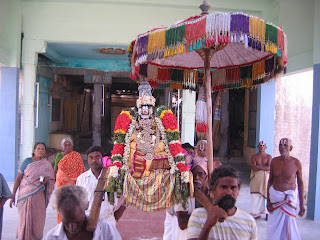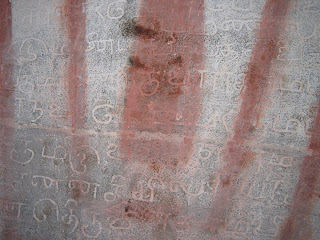Gold Offerings to the temple were to be utilised for Vedic School and the Hospital at Thiru Mukoodal

Inscriptions provide rich insights into the salaries of the Vedic Teachers, number of Vedic Teachers/ Students, Number of beds in the hospital as well as the hospital staff and their salaries
Inscription also records the presence of the Barber at the Hospital and the salary paid to him
Inscription in ancient temples gives one an insight into the historical chronology of the temple, the life style of the town and the architectural patterns at the temple depending on when it was constructed and later renovated and the kings who lived during that period.
Interestingly at the 2000 year old Appan Venkatesan temple in Thiru Mukoodal in Pazhaya Seevaram about 12kms east of Kanchipuram, inscriptions provide us with an indepth insights into the kind of health care facilities available at that time, the number of staff involved and even the salary paid to them.
While presence of Vedic schools and the loud recital of the Vedas was not uncommon in those days, insights through the inscriptions here at Thiru Mukoodal give us an indication on the extent to which it was prevelant in that early Pallava Period.
Earliest Inscription- Late 9th Century
An inscription in Tamil dating back to 893AD to the rule of Pallava Nripatunga Varma records a gift of 30 Kalanju of Gold for perpetual lamp. The assembly of Siyapuram entrusted with the gift agreed to supply oil for the lamp from the interest on the capital amount. Interest was fixed at 3 Manjadi per Kalanju. The Oil was to be supplied at 40 Nali per Kalanju.
A 1013AD inscription relating to Raja Raja Chola I records the gift of gold and land for offerings. Another inscription dating to the same year and the ruler records an agreement to pay taxes on certain temple lands from the interest on a specified quantity of gold which they had received from temple treasury.
Conduct of Maasi Magam Festival
On the western wall, a 1015AD inscription relating to Rajendra I records the gift of gold for offerings on Maasi Magam Festival. The gold to be offered was weighed and found to be equal to 3 Kalanju, interest fetched one Manjadi per year. Paddy was sold at 40 Kadi per Kalanju.
There is another inscription dating to 1016-17AD to the rule of Rajendra I recording the gift of paddy for offerings and festival on new Moon days.
Rajendra I- Gift of Sheep for lamp
A 1017AD inscription on the Western Wall relating to Rajendra I records the gift of 90sheep for lamp, a 1021AD inscription records gift of 90sheep and a 1023AD inscriptions records the gift of 113sheep for a lamp. An agreement was entered in 1028AD by the Vaikhanasas to use surplus paddy for reciting Thiruppadiyam at the temple.
The Huge Temple Garden and its functioning
A 1019-20AD inscription relating to Rajendra Chola Deva on the Western wall of the central shrine records the gift of Padagams of Garden land for flower garden. An agreement to have 7000baskets of manure spread on the field had two underlying conditions:
1. The priests of the temple were to have Kilbhogam rights while the Vaikhanasas were to have lease rights for cultivation
2. The bundles of hay weighing not less than one Kalam of Paddy each were to be collected from every tenant of the village by Vaikhanasas and used for the benefit of garden only and not to be sold for private purposes and permitting the temple garden the first claim over the irrigation of wet lands

A 1065AD inscription on the eastern wall of the first prakara relating to Raja Kesarivarma records the gift of two twilight lamps by a Brahmana lady.
On the South Wall of the temple a 1075AD inscription relating to Kulotunga I records the gift of land to the temple. An 1121AD inscription relating to Vikrama Chola Deva records the sale of land
Gold offering to be utilised for Vedic School and Hospital
Vira Rajendra Deva’s inscription in 1069AD records the order by the king that the 75 Kalanju of gold which the residents were paying at that time be entered as tax free Devadana to be utilised for God’s expense including the maintenance of Vedic School and the upkeep of the hospital. The hospital seemed to have 15beds. The physician was paid 90Kalams of Paddy and 8Kasu annually in addition of the grant of a land.
The surgeon was given 30Kalams of Paddy, two nurses were given 30kalams of Paddy and one Kasu annually. There was also a barber who was paid 15kalams of Paddy. In addition to the above, there were two persons who were to get medicinal herbs. These two got 60kalams of Paddy and two Kasu.
Vedic School

The Vedic schools taught Rig Veda and Yajur Veda. The vedic teachers were paid 60Kalams of paddy and 4Kasus annually. The bhattar at the temple was paid 120Kalam of Paddy and 10 Kasu annually
Inscriptions indicate that there were 10Brahmins who were studying Rig Veda, 10 Brahmins who were learning Yajur Veda, 20 Brahmins were studying Vyakarma and Rupavatara and 10 were learning Mahapancharatna. It also records the presence of 3 Saivite Brahmins, 5 Vaikanasas and two others.
Located about 70kms South of Madras, off the Chengalpet-Kanchipuram SH58 at the confluence of three rivers – Palar, Vegavathi and Cheyyar- is The temple is one km South of Pazhaya Seevaram Narasimha temple on the Salavakkam Highway.
For the story on Thiru Mukoodal, visit: http://prtraveller.blogspot.com/2010/05/thiru-mukoodal-appan-venkatesan.html











